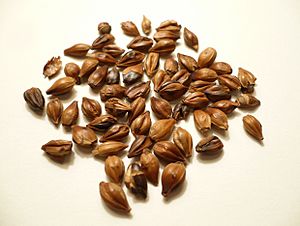Barley tea facts for kids
| Boricha (barley tea).jpg | |
| Type: | Herbal tea |
|
|
|
| Other names: |
|
| Origin: | East Asia |
|
|
|
| Quick description: | Tea made from roasted barley |
|
|
|
| Temperature: | 100 °C (212 °F) |
| Time: | 5–10 minutes |
Quick facts for kids Barley tea |
|||||||||||||||
|---|---|---|---|---|---|---|---|---|---|---|---|---|---|---|---|
| Chinese name | |||||||||||||||
| Traditional Chinese | 大麥茶 | ||||||||||||||
| Simplified Chinese | 大麦茶 | ||||||||||||||
| Literal meaning | barley tea | ||||||||||||||
|
|||||||||||||||
| Korean name | |||||||||||||||
| Hangul | 보리차 | ||||||||||||||
| Literal meaning | barley tea | ||||||||||||||
|
|||||||||||||||
| Japanese name | |||||||||||||||
| Kanji | 麦茶 | ||||||||||||||
| Kana | むぎちゃ | ||||||||||||||
|
|||||||||||||||
Barley tea is a roasted-grain-based infusion made from barley. It is a staple across many East Asian countries such as China, Japan, Korea and Taiwan. It has a toasty, bitter flavor.
In Korea, the tea is consumed either hot or cold, often taking the place of drinking water in many homes and restaurants. In Japan, it is usually served cold and is a popular summertime refreshment. The tea is also widely available in tea bags or bottled in Korea and Japan.
Etymology
In China, barley tea is called dàmài-chá (大麦茶; 大麥茶) or mài-chá (麦茶; 麥茶), in which dàmài (大麦; 大麥) or mài (麦; 麥) means "barley" and chá (茶) means "tea".
In Japan, barley tea is called mugi-cha (麦茶; むぎちゃ), which shares the same Chinese characters as Chinese mài-chá (麦茶; 麥茶), or mugi-yu (麦湯; むぎゆ), in which yu (湯; ゆ) also means "hot water".
In Korea, barley tea is called bori-cha (보리차), in which the native Korean bori (보리) means "barley" and Sino-Korean cha (차; 茶) shares the same Chinese character meaning "tea".
In Taiwan, barley tea is called be̍h-á-tê (麥仔茶), in which be̍h-á (麥仔) means "barley" and tê (茶) means "tea".
History
The Japanese aristocracy has consumed the tea since the Heian Period.. Samurai began to consume it in Sengoku period.. During the Edo period, street stalls specializing in barley tea became popular among the common people.
Availability

The tea can be prepared by boiling roasted unhulled barley kernels in water or brewing roasted and ground barley in hot water. In Japan, tea bags containing ground barley became more popular than the traditional barley kernels during the early 1980s and remain the norm today. The tea is also available prepackaged in PET bottles.
Bottled tea
Bottled barley tea is sold at supermarkets, convenience stores, and in vending machines in Japan and Korea. Sold mostly in PET bottles, cold barley tea is a very popular summertime drink in Japan. In Korea, hot barley tea in heat-resistant PET bottles is also found in vending machines and in heated cabinets in convenience stores.
Blended barley and similar teas
In Korea, roasted barley is also often combined with roasted corn, as the corn's sweetness offsets the slightly bitter flavor of the barley. The tea made from roasted corn is called oksusu-cha (corn tea), and the tea made from roasted corn and roasted barley is called oksusu-bori-cha (corn barley tea). Several similar drinks made from roasted grains include hyeonmi-cha (brown rice tea), gyeolmyeongja-cha (sicklepod seed tea), and memil-cha (buckwheat tea).
Roasted barley tea, sold in ground form and sometimes combined with chicory or other ingredients, is also sold as a coffee substitute.
See also
 In Spanish: Té de cebada para niños
In Spanish: Té de cebada para niños


